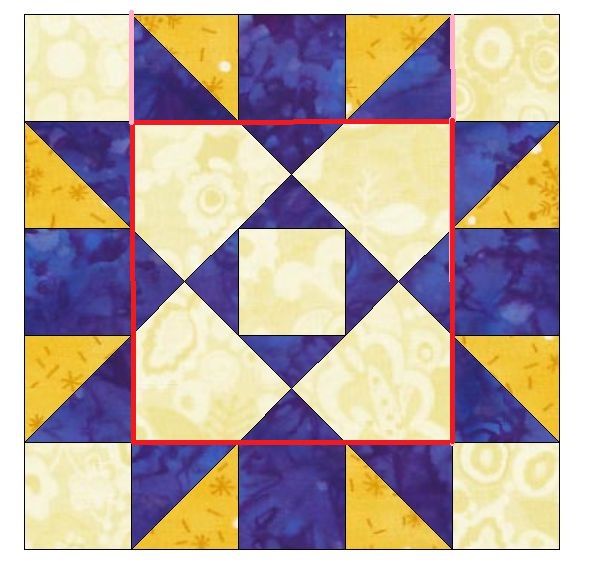When piecing, whether it’s a border or a block, don’t be afraid to “re-draw” the block if needed to make it work better. When looking at blocks, sometimes the obvious isn’t the easiest way to piece a block. Also, what I think is easy, may not be what you think is easy. When you look at a block you find in Electric Quilt, or a block in one of my of my designs, look at it in terms of how it would be easiest for YOU to piece.
But, what makes a block “easy”? Sometimes I have to weigh whether the easiest way to piece a block is going to be the easiest way to produce a perfect block. A reader even commented that this quilt looks hard. Some day, folks are going to realize that I don’t make hard quilts and even if I did, I wouldn’t share the pattern because my ability to draw the graphics is very limited. Almost any basic quilt block can be broken down into several ways to go about piecing it.
For an example, let’s look at one of the blocks in the Road to Brenham quilt.
Just seeing this block and not reading any farther, how would you put this block together? My first impression was this:
My first inclination was to piece together the center section, marked in red. To break it down a bit farther . .
For the center, those first thoughts were to make a square in a square in the center, the on two sides, add the background square with two sides trimmed off, then on the other two background pieces, add the two blue triangles.
But, always looking for an easier way, I thought of the typical nine patch.
This is an easy way to construct this block! There are four quarter square triangles and five plain triangles within that center. Simple! Easy! The outer piecing is simply half square triangles and squares. How easy! But you know what bothers me?
See the green arrows? When I see this block pieced with the center as a nine patch, it chops up the design I want to create. I want the center to look more like a square in a square, and I want those side blue “arrows” to be a single piece and not have the “points” pieced onto the base. Does that make sense?
To get the look I want, I might piece this block as follows:
I would start with a square in a square for the center. Then to piece the section that has the quarter square triangle, so as not to have so many seams, I would start with a background rectangle, then cut the corners off, and add a blue triangle to one side. Then add a blue triangle to background square, and put those to pieces together. (See the pink line.) Then for the section with the yellow, I would start with a blue rectangle, add the yellow triangle to one side, then trim the point on the blue triangle, similar to what we did on some of the pieces for the Road to Llano top.
This might not be technically the easiest way to piece this block and it may not be the way I would write the instructions, but I think this is the easiest way to create the look I want to create with this block.
If you were making this block, which way would you piece it?
Before writing the pattern, I will probably try several ways of piecing this block before deciding the best way to write the pattern.
This post is simply to get you to looking at the different possible ways to piece blocks and to show you a bit about how I decide which way to go about piecing my blocks.
This is a good time for a plug for EQ. I absolutely don’t think I could pieced without it. For me, it was one of those programs that seemed confusing and overwhelming at first but after a bit of playing and reading and going through some of the practices and examples in the tutorials, it’s such an easy program to use. I only know how to use the parts I use every day. There’s so much more to EQ than what I know how to use but it’s an amazing program and I encourage anyone who wants to play around with designing quilts or borders, to get the program and learn to use it.







Carolyn says
I’m not sure what it says about me, but I immediately went to the 9 patch that you have in the second breakdown photo. Maybe I always try to find the easy way? Truth be told, I DO try to find the easy way, in everything! I think it comes from being inherently lazy…
Jean says
An interesting puzzle. My first thought was working with the diagonal which you show in #5. I don’t think I would ever have thought of the 9-patch option! Just goes to show how we all think differently – and the same result can be obtained from multiple directions.
Gail Frenz says
Like you, I don’t like those patches that are shaped like “home plate” to be broken up. I would put this block in EQ and create paper foundations for it.
AngieG9 says
My first impulse when you had this on the wall was to start with #2, but after reading through all of the options you have laid out, I like option 5 best. Fewer seams, fewer turns, less bulk. That one just looks easier to me, and when I make it, that will be the way I’ll do it, unless you come up with an option where I can wiggle my nose and it makes itself.
Susan says
I probably would have done something similar to block 1.